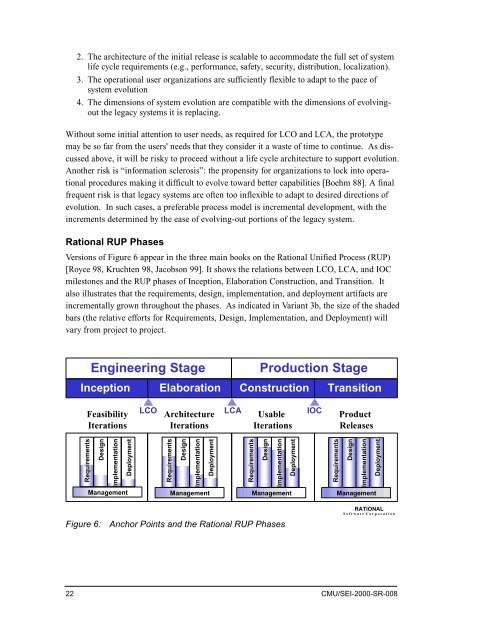00sr008
00sr008
00sr008
You also want an ePaper? Increase the reach of your titles
YUMPU automatically turns print PDFs into web optimized ePapers that Google loves.
2. The architecture of the initial release is scalable to accommodate the full set of system<br />
life cycle requirements (e.g., performance, safety, security, distribution, localization).<br />
3. The operational user organizations are sufficiently flexible to adapt to the pace of<br />
system evolution<br />
4. The dimensions of system evolution are compatible with the dimensions of evolvingout<br />
the legacy systems it is replacing.<br />
Without some initial attention to user needs, as required for LCO and LCA, the prototype<br />
may be so far from the users' needs that they consider it a waste of time to continue. As discussed<br />
above, it will be risky to proceed without a life cycle architecture to support evolution.<br />
Another risk is “information sclerosis”: the propensity for organizations to lock into operational<br />
procedures making it difficult to evolve toward better capabilities [Boehm 88]. A final<br />
frequent risk is that legacy systems are often too inflexible to adapt to desired directions of<br />
evolution. In such cases, a preferable process model is incremental development, with the<br />
increments determined by the ease of evolving-out portions of the legacy system.<br />
Rational RUP Phases<br />
Versions of Figure 6 appear in the three main books on the Rational Unified Process (RUP)<br />
[Royce 98, Kruchten 98, Jacobson 99]. It shows the relations between LCO, LCA, and IOC<br />
milestones and the RUP phases of Inception, Elaboration Construction, and Transition. It<br />
also illustrates that the requirements, design, implementation, and deployment artifacts are<br />
incrementally grown throughout the phases. As indicated in Variant 3b, the size of the shaded<br />
bars (the relative efforts for Requirements, Design, Implementation, and Deployment) will<br />
vary from project to project.<br />
Engineering Stage<br />
Production Stage<br />
Inception Elaboration Construction Transition<br />
Feasibility<br />
Iterations<br />
LCO<br />
Architecture<br />
LCA<br />
Usable<br />
IOC<br />
Iterations Iterations<br />
Product<br />
Releases<br />
Requirements<br />
Design<br />
Implementation<br />
Deployment<br />
Requirements<br />
Design<br />
Implementation<br />
Deployment<br />
Requirements<br />
Design<br />
Implementation<br />
Deployment<br />
Requirements<br />
Design<br />
Implementation<br />
Deployment<br />
Management<br />
Management<br />
Management<br />
Management<br />
Figure 6:<br />
Anchor Points and the Rational RUP Phases<br />
RATIONAL<br />
S o f t w a r e C o r p o r a t i o n<br />
22 CMU/SEI-2000-SR-008














